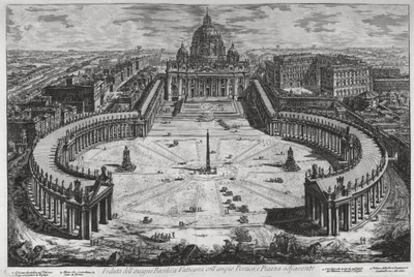Chiseled features: Piranesi's Eternal City
Madrid's Historical Library shows off its engravings of Rome for the first time
The first author of souvenir postcards was probably Giambattista Piranesi (1720-1778). Using amazing skill and precision, his Vedute di Roma (or, Views of Rome) are the most precise documents of how the Eternal City looked in the 18th century. The Historical Library of the Complutense University of Madrid has one of the most complete collections of engravings by Piranesi and his son Francesco: in total, more than a thousand prints that account for at least 90 percent of the production of both artists. These are now on display for the first time.
Given the large size of the vedute - some measure 50 by 70 centimeters - only 40 of them have been selected for the show. "The views of Rome are very important for their documentary value, because they show places as they were in the 18th century," explains Manuel Lizárraga, curator of the exhibition. But Piranesi was not just concerned about picking up the tiniest architectural details. "In his vedute he also included scenes of daily life - passers-by, vendors, beggars," adds Lizá-rraga. The selection adds up to a tour of Roman basilicas, monuments, public spaces, returning time and again to the famous ruins of classical Rome.
The 20-year-old Piranesi arrived in Rome from his native Venice, where he had trained as an engraver. He saw there was a market for small city views, which were snapped up by tourists. These were the days of the Grand Tour, the peregrination around classical and Renaissance heritage that began among European aristocracy in the 17th century.
"Piranesi revolutionized the market because he decided to make views of a huge size, with an unequalled amount of room for detail," the curator says. The commercial success of his vedute gave him time for serious study of Roman antiquity: "Piranesi was a theorist who always postulated the supremacy of this architecture over the Greek or the barbarian kind." His oeuvre reflects his various interests. There is the young visionary who imagined fantastic architecture, whimsical structures such as his famous carceri (prisons); then the passionate archeologist who analyzes and reproduces ruins almost scientifically. But Piranesi the vedutista evolved from 1748 to his death in 1778. "As you progress through the views you appreciate his stylistic evolution," says Lizárraga.
Giambattista Piranesi en la Biblioteca Histórica: vedute di Roma. Until September 9 at Biblioteca Histórica de la Universidad Complutense de Madrid, C/ Noviciado 3, Madrid. www.ucm.es/BUCM

Tu suscripción se está usando en otro dispositivo
¿Quieres añadir otro usuario a tu suscripción?
Si continúas leyendo en este dispositivo, no se podrá leer en el otro.
FlechaTu suscripción se está usando en otro dispositivo y solo puedes acceder a EL PAÍS desde un dispositivo a la vez.
Si quieres compartir tu cuenta, cambia tu suscripción a la modalidad Premium, así podrás añadir otro usuario. Cada uno accederá con su propia cuenta de email, lo que os permitirá personalizar vuestra experiencia en EL PAÍS.
¿Tienes una suscripción de empresa? Accede aquí para contratar más cuentas.
En el caso de no saber quién está usando tu cuenta, te recomendamos cambiar tu contraseña aquí.
Si decides continuar compartiendo tu cuenta, este mensaje se mostrará en tu dispositivo y en el de la otra persona que está usando tu cuenta de forma indefinida, afectando a tu experiencia de lectura. Puedes consultar aquí los términos y condiciones de la suscripción digital.
Últimas noticias
From digital curfews to blocking apps: How technology experts protect their children online
Why the price of coffee has skyrocketed: from Brazilian plantations to specialty coffee houses
Confined to a Cuban hospital: When electricity is a matter of life or death
The complicated life of Francesca Albanese: A rising figure in Italy but barred from every bank by Trump’s sanctions
Most viewed
- Why we lost the habit of sleeping in two segments and how that changed our sense of time
- Trump’s obsession with putting his name on everything is unprecedented in the United States
- Pablo Escobar’s hippos: A serious environmental problem, 40 years on
- The Florida Keys tourist paradise is besieged by immigration agents: ‘We’ve never seen anything like this’
- Charles Dubouloz, mountaineering star, retires at 36 with a farewell tour inspired by Walter Bonatti








































